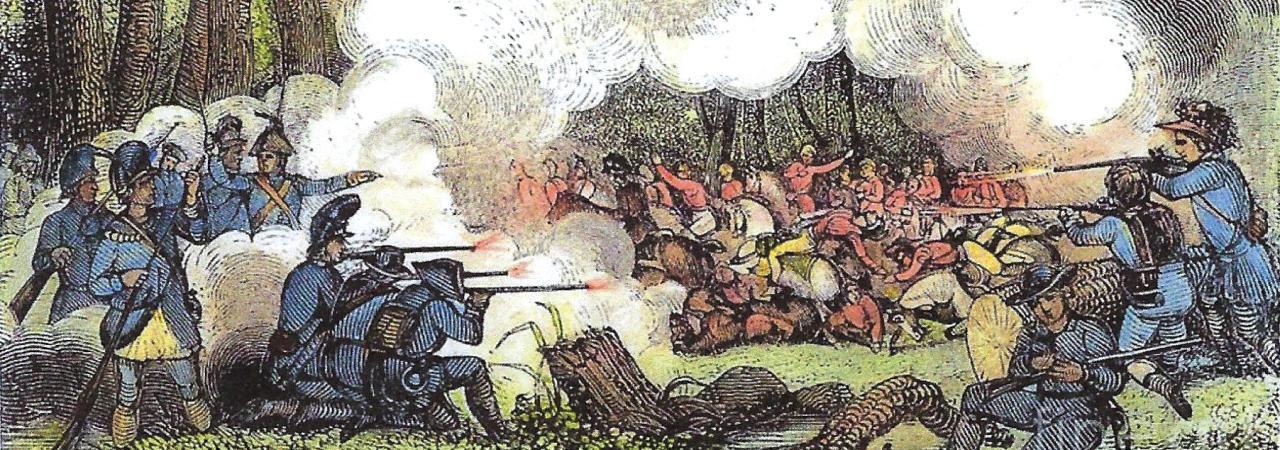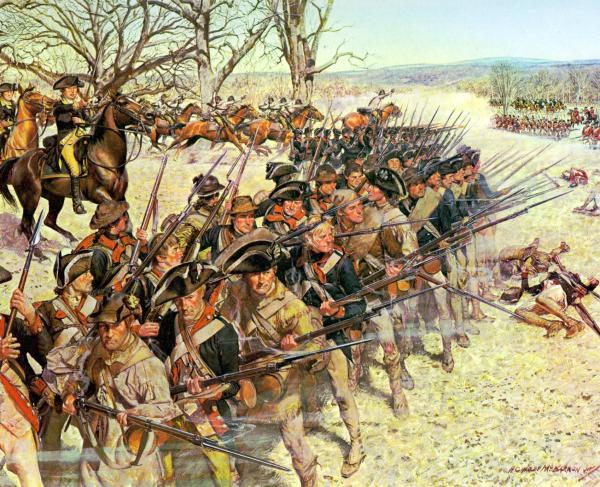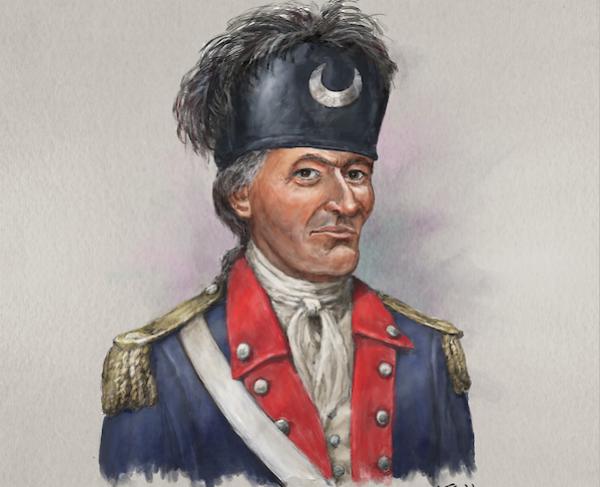
Engraving of Francis Marion defeating Major Frazier at Parker's Ferry, South Carolina.
Parker's Ferry
Colleton County, SC | Aug 30, 1781
Parker’s Ferry was a major thoroughfare crossing the Pon Pon River (Edisto River) about 33 miles west of Charleston. Here Brigadier General Francis Marion planned a famously successful ambuscade. British and Loyalist troops were operating in the summer of 1781 throughout the Lowcountry around Charleston, foraging for provisions and attempting to suppress the Patriot militia. Colonel William Harden commanded a small Patriot militia band south of the Pon Pon River and asked for more assistance in resisting these British patrols.
On August 10, 1781, Major General Nathanael Greene dispatched Marion to assist Harden. After the aborted ambush at Godfrey's Savannah on August 27, Marion sent Lieutenant Colonel Peter Horry to Cheeha where there were three British schooners taking on rice, guarded by 30 men. The British heard the Patriots approach and sailed downriver before they arrived. Marion learned that a Loyalist force of 100 troops commanded by William “Bloody Bill” Cunningham was at the Pon Pon River to join a larger force of British regulars, Hessians, and other Loyalist militia. Patriot patrols reconnoitered the British positions as too strong to attack. At night Marion placed men on the causeway to observe the British movements. A British patrol came out looking for Marion's force but were not able to find their camp in the dark. On August 29, the British moved to Isaac Hayne's Plantation and Marion followed again looking for a fight and he set up his camp five miles away to the east.
Marion placed his 445 troops in the thick woods about the causeway leading to Parker’s Ferry. Several dragoons galloped forward to entice the more than 600 Loyalist, British and German troops to chase them back into a Patriot trap. As shots were fired, British Lieutenant Colonel Ernest Leopold von Borck ordered Major Thomas Fraser and his dragoons to charge to the scene. Fraser’s troops galloped blindly into the “gauntlet” that Marion set for them.
Marion reported the action that day: “The 30th I went below them and formed an Ambuscade in a thick wood Within a mile of Parkers Ferry within forty yards of the road which the Enemy must come, here I Informed of upwards of one hundred toreys under a Col. Cunningham from Dorchester & Stono Laying on the banks of the river at Parkers Ferry waiting for Lt Col De Benin [Fredrich von Benning] who Comman(d)ed the Enemys force. My right Division of about Eighty men was Commanded by Maj [Harden] who I ordered to retire one hundred yards from the Line, & to march up when the firing began on the left; my Swordsmen of Sixty horse I sent under Maj [George] Cooper to fall in the rear of the Enemy to Draw their Attention that way & to follow them whenever they moved, & to keep in sight, with positive orders to charge their Enemys rear at all hazards, as soon the firing became Generall. Here I waited until sunset when part of the toreys from the ferry came on which I Intended should pass, but they discovered on of my men & Challenged, not Answering[,] they fired, & I could not restrain the men longer they returned in which made them immediately return back on the spur. I sent a few horse after them which rund them a Cross the river. The enemy hearing the fire & being on their way down Immediatly sent their Cavalry to resque them & came on full speed, & receved the fire of the whole Line Runing The Gauntlet through them. The Infantry Immedia[tely] Appeared before us & a heavy fire Insued which Continued for Some time, but unluckily some Villains Cryed out they ware flankings on the right & penetrating the wood[;] they immediately broke & while We ware rallying them & forming the second[d] Line in front of the horses, which was piquetted two hundred yards from the first line[,] the Enemy took that Oppertunity, carry off their field p & wounded & retreated on a trott, Leaving twenty men & twenty three horses Dead on the spott.”
Harden's men moved back 100 yards from the ambush line so they could be used as reserves. Major Samuel Cooper’s 60 swordsmen were told to attack the rear of the enemy after the ambush was initiated. They then waited for the British. Lieutenant Colonel Ernst Leopold von Borck left Hayne's Plantation in mid-afternoon with his infantry. He had two pieces of artillery in front of the column while Fraser and his mounted South Carolina Royalists were in the rear of the column. It was almost dark when they stumbled into a firefight between Marion's men and Loyalists who just discovered them. Fraser sent Lieutenant Stephen Jarvis charging forward while he placed three other divisions on the road and to the left and right of the road. Mounted Patriots charged Jarvis, who reversed course quickly. Fraser believed that these were Harden's men and ordered his cavalry in full gallop to intercept them. Marion now had the British right where he wanted them and instantly Fraser's horsemen were surrounded. At a distance of 40 yards, the Patriots opened up with buckshot and downed the British dragoons. Fraser rallied and tried to charge, but the Patriots delivered a second and a third volley. There was no way for Fraser to attack into the thick trees and nearby swamp, so he withdrew down the causeway, down the full length of the ambush. British Captain Archibald Campbell was wounded twice, and Fraser was badly bruised when his horse was killed and the rest of his cavalry rode over him as he lay in the road.
British casualties at 125 killed and 80 wounded were heavy, while Marion only suffered one man killed and three wounded. The Patriots continued to occupy the causeway for three more hours until Marion saw a large body of infantry with a field piece coming their way. His riflemen fired upon the field piece, wounding and killing some British accompanying it. Marion’s victory here directly impacted the Battle of Eutaw Springs, nine days later, by depriving British horse not available to fight there on September 8. Marion maneuvered through enemy territory back to the Santee and joined Greene to command that battle’s right militia line at Eutaw Springs. Parker’s Ferry is the exemplar of Marion’s guerilla warfare tactics which contribute to the extraordinary legend of the Swamp Fox. The battlefield is located near Jacksonborough which holds an impressive cluster of historic sites, including Pon Pon Church, the grave of the Southern martyr Isaac Hayne, and the capital of South Carolina in 1782 where civil government was re-established.
Parker's Ferry: Featured Resources
All battles of the Southern Theater 1780 - 1783 Campaign
Related Battles
4
205



